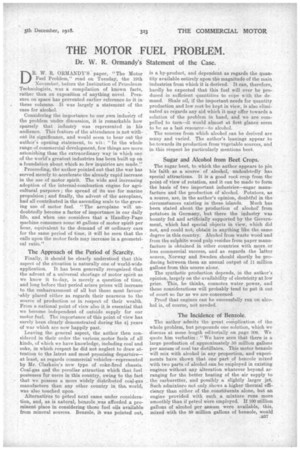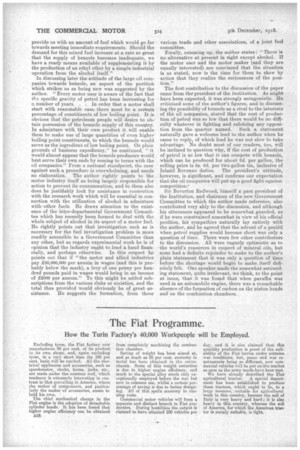THE MOTOR FUEL PROBLEM.
Page 15

Page 16

If you've noticed an error in this article please click here to report it so we can fix it.
Dr. W. R. Ormandy's Statement of the Case.
IDR. W. R. ORMANDY'S paper, "The Motor Fuel Problem," read on Tuesday, the 19th November, before the Institution of Petroleum Technologists, was a compilation of known facts, rather than an exposition of anything novel. Pressure on space has prevented earlier reference -to it in these columns. It was largely a statement of the case for alcohol.
Considering the importance to our own industry of the problem under discussion, it is remarkable how sparsely that industry' was represented in his audience. This feature of the attendance is not withoat its significance, and would seem to bear out the author's opening statement, to wit: "In the whole range of commercial development, few things are more astonishing than the extraordinary way in which one of the world's greatest industries has been built up on a foundation about which so few inquiries are made."
Proceeding, the author pointed out that the war has served merely to accelerate the already rapid increase in the use of motor spirit. The wide and increasing adoption of the internal-combustion engine for agricultural purposes ; the spread of its use for marine propulsion ; and finally, the advent of the aeroplane, had all contributed in the ascending scale to the growing use of motor fuel. "The aeroplane will undoubtedly become a factor of importance in our daily life, and when one considers that a Handley-Page machine consumes some40 gallons of motor spirit per hour, equivalent to the demand of 40 ordinary cars for the same period of time, it will be seen that the calls upon the motor fuels may increase in a geometrical ratio."
The Approach of the Period of Scarcity.
Finally, it should be clearly understood that this aspect of the situation is naturally one of world-wide application. It has been generally recognized that the advent of a universal shortage of motor spirit as we know it to-day, is merely a question of time, and long before that period arises prices will increase to the embarrassment of all but those most favour-ably placed either as regards their nearness to the source of production or in respect of their wealth. From a national point of view also it is essential that we become independent of outside supply for our motor fuel. The importance of this point of view has surely been clearly demonstrated during the 4i years of war which are now happily past.
Leaving the general aspect, the author then considered in their order the various motor fuels of all kinds, of which we have knowledge, including coal and coke, in which respect he did not neglect to draw attention to the latest and most promising departure— at least, as regards commercial vehicles—represented by Mr. Clarkson's new type of coke-fired chassis. Coal-gas and the peculiar attraction which that fuel possesses fer users in this country, owing to the fact that we possess a more widely distributed coal-gas manufacture than any other country in the, world, was also touched upon. _ Alternatives to petrol next came under consideration, and, as is natural, benzole was afforded a prominent place in considering those fuel oils available from mineral sources. Benzole, it was pointed out, is a by-product, and dependent as regards the quantity available entirely upon the magnitude of the main industries from which it is derived. It can, therefore, hardly be expected that this fuel will ever be produced in sufficient quantities to cOpe with the demand. Shale oil, if the important needs for quantity production and low cost be kept in view, is also eliminated as regards any aid which it may offer towards a solution of the problem in hand, and we are compelled to turn—it would almost at first glance seem to he as a Tait resource—to alcohol.
The sources from which alcohol can be derived are many and varied. The author's leanings appear to be towards its production from -vegetable sources, and in this respect he particularly mentions beet.
Sugar and Alcohol from Beet Crops.
The sugar beet, to which the author appears to pin his faith as a source of alcohol, undoubtedly has special attractions. It is a good root crop from the point of view of rotation, and it can be made to form the basis of two important industries—sugar manufacture and the production of alcohol. Potatoes, as a source, are, in the author's opinion, doubtful in the circumstances existing in these islands. Much has been stated about the production of alcohol from potatoes in Germany, but there the industry was bounty fed and artificially supported by the Government, which had special objects in view, which did not, and could not, obtain in anything like the same degree in this country. Alcohol from waste wood and from the sulphite wood pulp residue from paper manufacture is obtained in other countries with more or less commercial success, and as regards the latter source, Norway and Sweden should shortly be producing between them an annual output of 11 million gallons from this source alone.
The synthetic production depends, in the author's opinion, largely on the availability of electricity at low price. This, he thinks, connotes water power, and these considerations will probably tend to put it out of court so far as we are concerned.
Proof that engines can be successfully run on alcohol is, of course, not needed.
The Incidence of Benzoic.
The author admits the great complication of the whole problem, but propounds one solution, which we discuss at some length edithrially on page f309. We quote him verbatim : "We have seen that there is a large production of approximately 50 million gallons per annum of coal tar distillates. This motor benzoic will mix with alcohol in any proportion, and experiments have shown that one' part of benzoic mixed with two parts of alcohol can be employed in existing • engines without any alteration whatever beyond arranging for the better heating of the air supply to the carburetter, and possibly a slightly larger jet. Such admixture not only shows a higher thermal efficiency than either of the constituents alone, but an engine provided with, such, a mixture runs more smoothly than if petrol were employed. If 100 million gallons of alcohol per annum were available, this, mixed with the 50 million gallons of benzoic, would provide us with an amount of fuel which would go far towards meeting immediate-requirements. Should the demand for this mixed fuel increase at a rate so great that the supply of benzole becomes inadequate, we have a ready means available of supplementing it by the production of an ethyl ether by a simple industrial operation from the alcohol itself."
In discussing later the attitude of the large oil companies towards benzoic, an aspect of the position which strikes us as being new was suggested by the author. "Every motor user is aware of the fact that the specific gravity of petrol has been increasing for a number of years. . . In order that a motor shall start with reasonable ease there must be a certain percentage of constituents of low boiling point. It is obvious that the petroleum people will desire to ob-. tain possession of the benzole supply of this country. In admixture with their own product it will enable them to make use of large quantities of even higher" boiling point constituents, to which the benzole would serve as the ingredient of low boiling point. On plain grounds of business expediency," he eontiuued, "it would almost appear that the benzoic producers would best serve their own ends by coming to terms with the oil companies." From a national standpoint, the case against such a procedure is overwhelming, and needs no elaboration. The author rightly points to the motor industry itself as being largely responsible for action to prevent its consummation, and to them also does he justifiably look for assistance in connection with the research work which will be essential in connection with the utilization of alcohol in admixture with-other fuels. He draws attention to the existence of the inter-departmental Government Committee which has recently been formed to deal with the whole subject of alcohol in its aspect of a motor fuel. He rightly points out that investigation such as is necessary for the fuel investigation problem is more readily accessible to a Government Committee than any other, but as regards experimental work he is of opinion that the industry ought to lend a hand financially, and perhaps otherwise. In this respect ine points out that if "the motor and allied industries pay £50,000,000 per annuns in wages (and this is probably below the mark), a levy of one penny per hundred pounds paid in wages would bring in an income of 22000 per annum." To this might be added subscriptions from the various clubs or societies, and the total thus provided would obviously be of great assistance. He suggests the formation, from these various trade and other associations, of a joint fuel committee.
Finally, summing up, the author states: "There is no-alternative at present in sight except alcohol. If the motor user and the motor maker (and they are equally interested) are convinced that the situation is. as stated, now is the time for them to show by action that they realize the seriousness of the position."
The first contribution to the discussion of the paper came from the' president of the Institution. As might have been expected, it was strongly antagonistic. He criticised some of the author's figures, and in discussing the possibility of benzoic as a rival to the interests of the oil companies, gated that the cost of production of petrol was so low that there would be no difficulty whatever in fighting and subduing any opposition from the quarter named. Such a statement naturally gave a welcome lead to the author when he came to reply, of which lead he was not slow to take advantage. No doubt most of our readers, too, will be inclined to question why, if the cost of production of petrol is so low that it can compete with benzole, which can be produced for about 6d. per gallon, the selling price is Os. 6d. per two-gallon tin, inclusive of inlaud Revenue duties. The president's attitude, however, is significant, and confirms our expectation that the oil_ companies will put up a good fight against competition..
Sir Boverton Redwood, himself a past president of the Institution, and chairman of the new Government Committee to which the author made reference, also contributed very ably to the discussion, and although his utterances appeared to be somewhat guarded, as if he were constrained somewhat in view of his official position, his sympathies naturally lay entirely with the author, and he agreed that the advent of a peridd when petrol supplies would become short was only a question of time. There were few other contributors to the discussion. All were vaguely optimistic as to • the world's resources in respect of mineral oils, but none had a definite rejoinder to make to the author's plain statement that it was only a question of time before the shortage would begin to make itself definitely felt. One speaker made the somewhat astounding statement, quite irrelevant, we think, to the point at issue, that it was found that when paraffin was used in an automobile engine, there was a remarkable absence of the formation of carbon on the piston heads and on the combustion chambers.






















